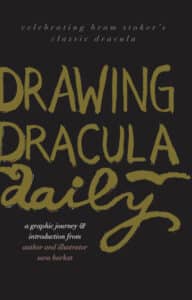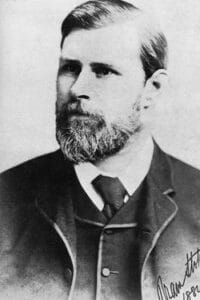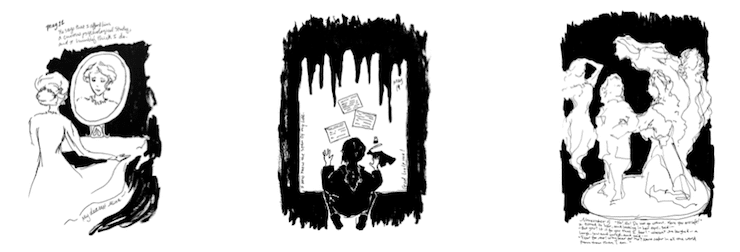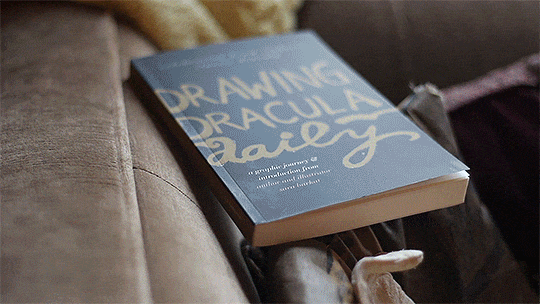Inspired by “Dracula,” Sara Barkat draws 200 graphics
Bram Stoker (1847-1912) was an Irish theater critic and writer who became friends with Sir Henry Irving (1838-1905), one of Britain’s leading stage actors of the late 19th century. A favorable review of Irving in Hamlet led to their friendship and eventually to Stoker becoming business manager of Irving’s Lyceum Theatre in London’s West End.
It was Irving who suggested that Stoker and his family visit Cruden Bay in Scotland, which Stoker would use as the setting for two novels (and eventually architectural inspiration for Dracula). Irving also suggested a visit to Whitby, on the coast of northeastern England, the port from which Captain James Cook set forth on his worldwide voyage and the site of St. Mary’s Church and the ruins of Whitby Abbey. The church and abbey, despoiled by Henry VIII during the dissolution of monasteries, become a significant setting in Dracula.

The original cover of “Dracula” in 1897
When it was published in 1897, the story of the vampire Count Dracula enthralled readers. It’s also been the source of countless movies, stage plays, and books. More recently, the story became the substance of the Dracula Daily Book Club on Substack, posted daily to correspond with the dates in the story itself. More than 250,000 people signed up.
The vampire is still popular. You may have thought he had a stake driven into his heart, and he did, but his story has become a living legend.
One of those who signed up was writer and artist Sara Barkat. She was so taken with the story and the book club that she began to draw graphic illustrations for the daily entries. She drew nearly 200 of them, stretching from May to November.

The illustrations lean to the impressionistic, but they are clearly defined. Each depicts a specific scene. Each has a date, and each includes the reference text from the novel, so you know precisely what’s being illustrated. Collectively, they represent what might be called an “artist’s notes” of the novel.

Bram Stoker
In her introduction, Barkat explains that she aimed to do a daily drawing for each Dracula Daily entry. She largely succeeded, she says, missing only two days. The collection begins with Count Dracula’s castle in Transylvania and ends with the epilogue seven years after the vampire’s death and destruction. Interestingly, Stoker, while well traveled, never visited eastern Europe. He apparently based the castle on Stains Castle near Cruden Bay.
Sara Barkat is the author of the National Indie Excellence Awards finalist collection The Shivering Ground & Other Stories, editor of Earth Song: A Nature Poems Experience, and illustrator of The Yellow Wall-Paper: A Graphic Novel, The Picture of Dorian Gray, and The Strange Case of Dr. Jekyll and Mr. Hyde.
Matt Kirkland, the mastermind behind Dracula Daily, has posted the daily entries for two years running, and he intends to do it again in 2024, once again beginning in May, when the novel itself begins. Drawing Dracula Daily would make a fine companion volume. Or, even if you don’t know or haven’t read the story, you can enjoy the illustrations on their own merits.
Photo by photonoumi, Creative Commons, via Flickr. Post by Glynn Young.
How to Read a Poem uses images like the mouse, the hive, the switch (from the Billy Collins poem)—to guide readers into new ways of understanding poems. Anthology included.
“I require all our incoming poetry students—in the MFA I direct—to buy and read this book.”
—Jeanetta Calhoun Mish
- Longfellow’s “Paul Revere’s Ride”: Creating a National Legend - April 17, 2025
- Poets and Poems: Katie Kalisz and “Flu Season” - April 15, 2025
- Poets and Poems: Michelle Ortega and “When You Ask Me, Why Paris?” - April 10, 2025




Laura Lynn Brown says
I read her illustrated “The Yellow Wallpaper” and loved the illustrations — seeing what she saw helped me to re-imagine the story, which I first read in college, like lots of people.
Thanks for the three images and the tantalizing zip-through video! I imagine this might encourage people to visualize more when we read, or even to do some sketches to engrave some scenes in memory.